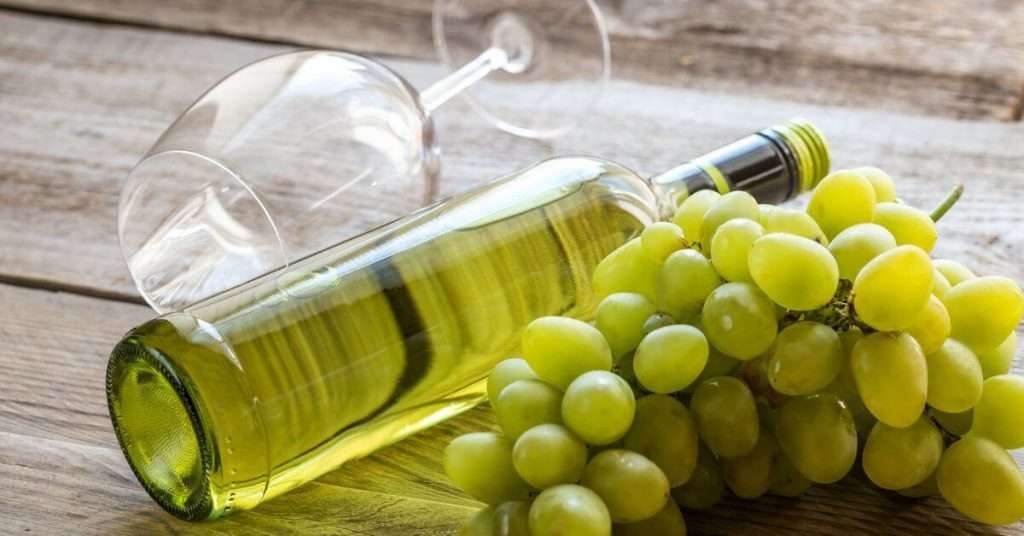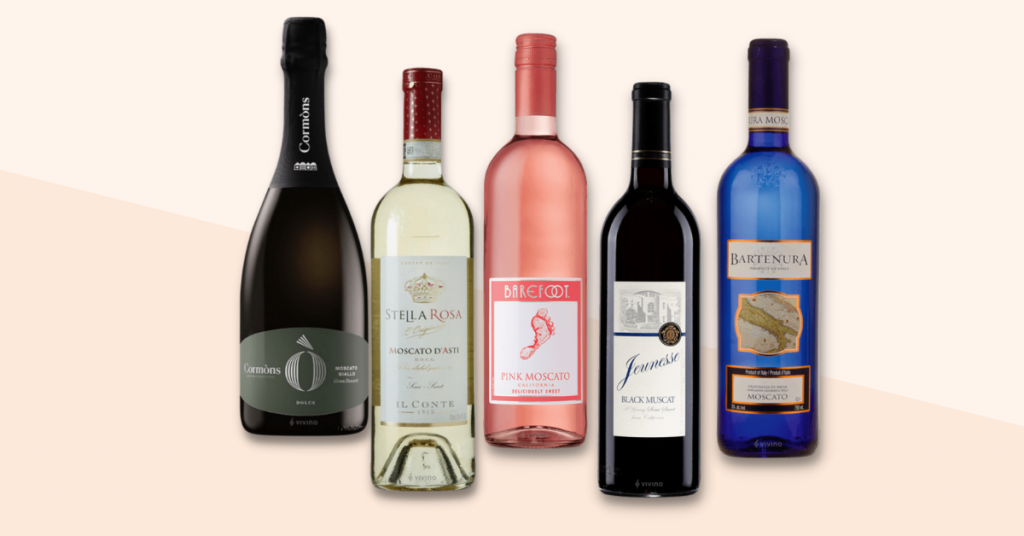Moscato Sparkling Wine- A Style Guide
Moscato sparkling wine is a style of Italian wine made from the Muscat Blanc grape.
That may sound simple but the reality can get a little trickier.
First of all there are five popular styles of Moscato (including the most popular style sparkling Moscato). As if that wasn’t enough, there’s an Italian wine region and a bunch of unrelated grapes that sound similar!

Muscat Blanc (aka Mother Muscat) – The Grape
Muscat is one of the oldest (possibly the oldest) family of grapes in the world.
Some consider it to be the grape from which all other vinifera grapes derived (if you hear a hard core fan call it Mother Muscat now you know why).
It’s best known in its Italian form as Moscato d’Asti. But it’s also called Moscatel in Spain and Portugal.
There are literally hundreds of mutations and crossings of Muscat, the most famous and highly regarded is Muscat Blanc à Petits Grains.
Muscat has a distinctive floral aroma, and can be made into a wide variety of wines — dry, medium, sweet, sparkling, or dessert wine.
Muscat has low acidity, which makes it not especially suitable for aging (unless it’s fortified Muscat).
Muscadet – The Region
Muscadet is a region, not a grape. It’s the most well-known appellation of the Pay Nantis in Loire, France.
The grape used in these wines is Melon de Bourgogne, which is totally unrelated to Muscat. The wines are dry, fairly neutral, laced with minerality and often a slight perception of salinity.
Phenomenal with raw oysters.
Similar Sounding Grapes Not Found In Moscato
Consumers are often confused with these grapes thinking they are moscato. They are not. And if you’re one that is confused by the grapes, consider yourself now in the know.
Muscadelle
Muscadelle is one of the three grapes (along with Sauvignon Blanc and Semillon) permitted in White Bordeaux blends.
Totally unrelated to Muscat, although it also has a marked grapey, floral characteristic. It would be rare to see Muscadelle produced as a single variety wine.
It’s most famously used in the fortified wines of Rutherglen (Australia) as Topaque.
Muscadine
Not related to Muscat. Muscadine is a group of grape varieties native to Central and North America, concentrated mostly in the southeastern United States.
Muscadine has thick skins and doesn’t usually get fully ripe, and usually requires chaptalization (adding sugar), which is why these wines are sweet. Very sweet.
The vine is resistant to phylloxera, which may be its best quality. Very little wine is made from Muscadine, the most well known is probably Scuppernong, which is native to North Carolina.
Muscardin
Not related to Muscat. A super obscure grape variety from the southern Rhone, and one of the 14 approved grape varieties for Chateauneuf-du-Pape.
Types Of Moscato

Still Moscato
Still Moscato is simply a style of Moscato that is not sparkling or bubbly in any way.
This style is often a bit drier (less sweet) than other Moscato wines. The smell is still quite sweet and fruity, making it drink a little sweeter than you would expect.
Still Moscato is normally made with Muscat Blanc grapes.
Sparkling Moscato
Most wines labeled Moscato will be sparkling with lovely light bubbles.
The most popular sparkling Moscato is the Italian wine, Moscato d’Asti. This wine is actually semi-sparkling with only a light fizz.
The other popular sparkling Moscato is Asti Spumante, which is more aggressively sparkling.
Pink Moscato
Less popular than the traditional sparkling Moscato is pink Moscato.
Possibly dreamt up to take advantage of the popularity of Rosé, pink Moscato has a light ruby-pink color caused by a blend with just a tiny addition of Merlot grapes.
It will taste similar to regular Moscato with a slight taste of red berries.
Red Moscato
Also called Black Muscat, this wine is quite rare and made from the Black Muscat grape.
Moscato Dessert Wine
The sweetest of Moscato’s are made as dessert wines. Moscato generally has a lower alcohol content than other dessert wines.
Moscato dessert wines are made all over including Portugal, Sicily, Greece, and even Australia.
How To Serve Moscato
Moscato is best served at a temperature of around 45-50 degrees Fahrenheit.
Moscato Food Pairing
Moscato is a light, sweet wine that pairs well with fruit, sweets, and cheese. Check out these pairing ideas and experiment with some of your own!
Fruit: Moscato goes well with all sorts of fruit, from freshly sliced peaches to grilled pineapple. It is also a good choice for fruit salad or fruit-based desserts.
Sweets: Moscato pairs well with cookies, cake, and other sweet treats. It is also a good choice for serving with chocolate.
Cheese: Moscato is a good choice for pairing with soft cheeses like ricotta or Brie. It can also be enjoyed with stronger cheeses, such as Parmesan or aged cheddar.
Savory dishes: Moscato can be used to deglaze a pan after cooking meats or vegetables. It can also be added to sauces and soups for a touch of sweetness.
Moscato Wine FAQ’s
What does moscato mean?
Moscato is a type of white wine. The name comes from the Italian word for muscat, which is the grape that is used to make this wine. Moscato wines are known for their sweetness and are often served as dessert wines. They can also be used in cocktails or simply enjoyed on their own.
How do you pronounce Moscato?
Sounds like muh·skaa·tow
Can you get Moscato in a can?
Yes, you can definitely find Moscato in a can! In fact, it’s becoming increasingly popular to drink wine from a can, especially among young adults. Moscato is a great option for those who want to enjoy a sweet, refreshing wine without having to open a bottle. Plus, it’s easy to take cans of moscato with you on the go.
Should moscato be chilled?
Moscato is best served at a temperature of around 45-50 degrees Fahrenheit.
How to make a moscato spritzer?
Moscato spritzers are a simple and refreshing drink absolutely lovely for a hot day. To make a Moscato spritzer fill your glass about ¾ full of Moscato, add a healthy splash of sparkling water (you can use any brand you have on hand) and top with orange juice or any other refreshing fruit juice. If you’re feeling fresh, use fresh citrus juice, or even throw some fresh berries in for flavor and color! Serve over ice.
Is Moscato a sparkling wine?
Most Moscato’s are sparkling with some styles less sparkling, like Moscato d’Asti, while others like Asti Spumante are very strongly sparkling.
Is Moscato a wine or champagne?
Moscato is a sparkling wine like Champagne is a sparkling wine. While only wines produced in the Champagne region of France can be called Champagne, both are sparkling wines.









